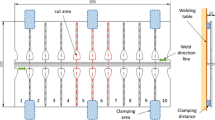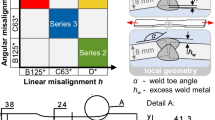Abstract
The classificatory method is considered a straightforward and robust procedure for the assessment of welded joints in metallic structures. The methodology adopts a set of S–N diagrams with a conservative survival rate, which expresses the fatigue performance of the most employed joint configurations. In the design phase, the adoption of a structural detail correlated with a higher curve in the set conducts to high structural integrity. Nevertheless, fatigue phenomenon is essentially multifactorial and, consequently, several optimizing alternatives may be applied for life increasing. Studies focused on continuous (weldless) parts correlate fatigue performance with the material ultimate strength. Transferring this approach to welded parts, adoption of a high-strength filler metal, or any procedure intended to mitigate metallurgical inhomogeneity in the weld-affected region may propitiate fatigue life improvement. In other sense, issues related to bead geometry, notably the notch effect associated with weld toe, are also reported to have an essential influence on fatigue life of structural details. This work aims to counterbalance material and bead geometry aspects related to fatigue performance of butt joints subjected to repeated transverse loading. Two welding processes, FCAW and GMAW, as well as different filler metals and parameters, were adopted for specimens manufacturing. The ASTM-A572-Gr.50 steel was employed as a parent metal. After welding, FCAW joints presented better mechanical and metallurgical characteristics. Additionally, in order to characterize the relevance of the notch effect, half of the specimens had the original bead geometry maintained, while the others underwent a manual removal of the reinforcement. The obtained results indicate that FCAW joints present better fatigue performance in the as-welded state. However, after removing the reinforcements, both welding processes attained similar results, suggesting that the notch effect has more relevance for fatigue life than mechanical and metallurgical characteristics of the joint. Consequently, the superior performance presented by the FCAW joints in the as-welded state is assigned to the final shape of the reinforcements, which is smoother than in the GMAW case. The higher capacity of penetration and better filler metal wettability propitiated by the FCAW process is responsible for the lower notch effect.












Similar content being viewed by others
Abbreviations
- AF:
-
Acicular ferrite
- FCAW:
-
Flux-cored arc welding
- FEF:
-
Fatigue enhancement factor
- GBF:
-
Grain boundary ferrite
- GMAW:
-
Gas metal arc welding
- HAZ:
-
Heat-affected zone
- P:
-
Perlite
- PF:
-
Polygonal ferrite
- QF:
-
Equiaxial ferrite
- S–N (diagram):
-
Fatigue strength versus cycle number (diagram)
- WF:
-
Widmanstätten ferrite
References
Haldimann-Sturm SC, Nussbaumer A (2008) Fatigue design of cast steel nodes in tubular bridge structures. Int J Fatigue V30(3):528–537. https://doi.org/10.1016/j.ijfatigue.2007.03.007
Zerbst U, Ainsworth RA, Beier HTh, Pisarski H, Zhang ZL, Nikbin K, Nitschke-Pagel T, Münstermann S, Kucharczyk P, Klingbeil D (2014) Review on fracture and crack propagation in weldments—a fracture mechanics perspective. Eng Fract Mech 132:200–276. https://doi.org/10.1016/j.engfracmech.2014.05.012
International Organization for Standardization (2007) ISO 6520-1: welding and allied processes—classification of geometric imperfections in metallic materials—part 1: fusion welding
British Standard WEE/37 Technical Committee (2005) BS7910: guide to methods for assessing the acceptability of flaws in metallic structures
Gurney T (2006) Cumulative damage of welded joints. Woodhead Publishing Limited, Cambridge
American Welding Society—D1 Committee on Structural Welding (2010) AWS D1.1/D1.1 M:2010 structural welding code—steel
European Committee for Standardization (2002) Eurocode EN 1990:2002 + A1:2005 (E)—basis of structural design
European Committee for Standardisation (2003) Eurocode 3—EN1993-1-9, Design of steel structures—part 1.9: fatigue
Hobbacher A (2008) Recommendations for fatigue design of welded joints and components. International Institute of Welding IIW, Commissions XIII and XV, document IIW-1823-07
Jenney CL, O’Brien A (2001) Welding handbook, vol 1, 9th edn. American Welding Society, Miami
Maddox SJ (2002) Fatigue strength of welded structures, 2nd edn. Woodhead Publishing Ltd and The Welding Institute, Cambridge
Mishchenko A, Scotti A (2018) Tensões Residuais em Soldagem a Arco: Uma Visão Holística. Soldagem & Inspeção 23(1):93–112. https://doi.org/10.1590/0104-9224/SI2301.10
American Petroleum Institute (2016) Fitness-for-service. API RP-579-1/ASME FFS-1
Branco CM, Fernandes AA, de Castro PMST (1999) Fadiga de Estruturas Soldadas. Fundação Calouste Gulbenkian, Lisboa
Van Es SHJ, Kolstein MH, Pijpers RJM, Bijlaard FSK (2013) TIG-dressing of high strength steel butt welded connections—part 1: weld toe geometry and local hardness. Procedia Eng 66:216–225. https://doi.org/10.1016/j.proeng.2013.12.076
Haagensen PJ, Maddox SJ (2006) IIW recommendations on post weld improvement of steel and aluminum. International Institute of Welding (IIW) Commission XIII. IIW Document XIII-1815-00
Lassen T (1990) The effect of the welding process on the fatigue crack growth. Weld J 69:75S–81S
Lassen T, Récho N (2006) Fatigue life analyses of welded structures—FLAWS. ISTE Ltd., London
Maddox SJ (2003) Review of fatigue assessment procedures for welded aluminum structures. Int J Fatigue 25(12):1359–1378
ASTM International (2013) ASTM A572/572M—standard specification for high-strength low-alloy columbium-vanadium structural steel. https://doi.org/10.1520/a0572_a0572m-13a
American Welding Society standard AWS A5.18/A5.18 M (2017) Specification for carbon steel electrodes and rods for gas shielded arc welding
ESAB Welding Filler Metal Handbook (2016)
Lillemäe I, Remes H, Liinalampi S, Itävuo A (2016) Influence of weld quality on the fatigue strength of thin normal and high strength steel butt joints. Weld World 60(4):731–740. https://doi.org/10.1007/s40194-016-0326-8
Radaj D, Sonsino CM, Fricke W (2006) Fatigue assessment of welded joints by local approaches, 2nd edn. Woodhead Publishing, Cambridge
Lazzarin P, Tovo R (1998) A notch intensity factor approach to the stress analysis of welds. Fatigue Fract Eng Mater Struct 21:1089–1103
ASTM International (2015) ASTM E739 standard practice for statistical analysis of linear or linearized stress-life (S-N) and strain-life (ε-N) fatigue data. https://doi.org/10.1520/e0739-10r15
Radaj D, Sonsino CM, Fricke W (2009) Recent Developments in local concepts of fatigue assessment of welded joints. Int J Fatigue 31(1):2–11. https://doi.org/10.1016/j.ijfatigue.2008.05.019
Fricke W (2004) Fatigue design and structural hot-spot stress determination for welded joints. In: 9th Portuguese conference on fracture. https://www.researchgate.net/publication/263466234
Acknowledgements
The authors would like to thank the Manufacturing Laboratories of FURG (Federal University of Rio Grande) and IFSUL (Southern Federal Institute of Pelotas), as well as PRONEM—Programa de Apoio a Núcleos Emergentes, Ed. FAPERGS/CNPq 003/2011, Process No. 11/2046-8 for supporting the research activities.
Author information
Authors and Affiliations
Corresponding author
Additional information
Technical Editor: João Marciano Laredo dos Reis.
Publisher's Note
Springer Nature remains neutral with regard to jurisdictional claims in published maps and institutional affiliations.
Rights and permissions
About this article
Cite this article
da Silva, M.S., Souza, D., de Lima, E.H. et al. Analysis of fatigue-related aspects of FCAW and GMAW butt-welded joints in a structural steel. J Braz. Soc. Mech. Sci. Eng. 42, 67 (2020). https://doi.org/10.1007/s40430-019-2142-8
Received:
Accepted:
Published:
DOI: https://doi.org/10.1007/s40430-019-2142-8




